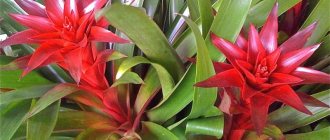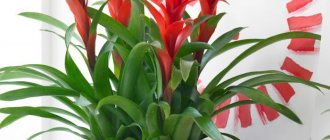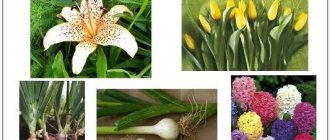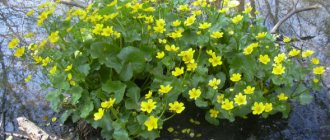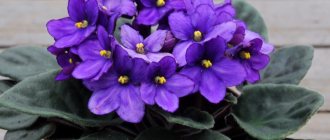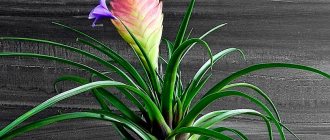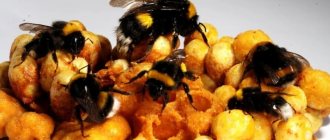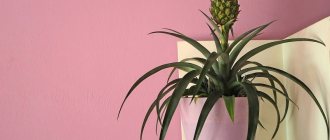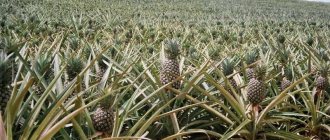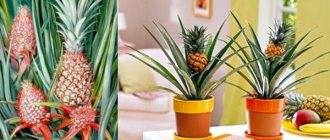Family Bromeliads
The Bromeliad family includes three subfamilies. This:
- Pitcairnioideae;
- tillandsiaceae (Tillandsioideae);
- bromeliads (Bromelioideae), or pineapple.
What does a bromeliad flower look like?
For your information! There are about 3 thousand species and varieties of this herbaceous perennial grass.
Indoor plants from the Bromeliad family: types and features
According to the description, bromeliad has a close relationship with the familiar pineapple, which is quite an edible fruit. And this is no accident, since they are relatives.
All types of crops are of floristic interest. But of these, the most popular are cryptanthus, guzmania, vriesia, indoor pineapple, echmea, neoregelia, billbergia, acanthostachis, neoregelia, nidularium.
Common features of all varieties and types:
- seasonal flowering, that is, in summer;
- the inflorescence is a modified, apical leaf rosette;
- ability to bloom only once. The flower stalk dies, leaving behind a bunch of babies.
For propagation, puppies (kicks) and seeds are used. The first method is used more often.
Note! Flowering can be accelerated by stimulating the flower with ethylene. It is released by fruits, such as apples.
General information about the Bromeliad family
The Bromeliad family includes ground-growing plants and epiphytes. The latter grow by clinging to nearby objects (trees, bushes, stones, buildings, etc.). However, they are not parasites. Nutrition is obtained from air (drops of moisture) and sunlight.
The leaves of the crop are dense and glossy. As they develop, they form a funnel-shaped rosette. The top of the flower changes over time (due to the bract leaves). An inflorescence grows from it (racemose, capitate, paniculate or spicate). The color of the brushes is very bright - all shades of red and yellow.
The flowering period depends on the species and can last from 2-3 weeks to 2-3 months.
Bromeliads - unique and recognized
The largest specimen of bromeliads is Puia Raimondi, whose height can reach four meters, and in flowering state up to ten meters.
Aerophyte - Tillandsia usneiformes, also called Louisiana or Spanish moss, is the most graceful plant of the “atmospheric” bromeliads. The favorite places to settle for these small individuals are thin tree branches, the spines of huge cacti, poles and telecommunication wires, where there is a lot of light and fewer dangerous herbivores. Drops of rain, dew and fog feed the plant with water, settling on the leaves. After all, their root system is very weak or completely absent. Its purpose is to strengthen itself on a support, and not to feed the outlet.
Terrestrial bromeliads are the complete opposite of epiphytes. Their gorgeous roots grow beautifully in the soil, feeding from it both water and nutrients necessary for the plant.
Some bromeliads like dry, rocky areas best. They live in the Mexican prairies and are called petrophilous, rock-loving, translated from the Greek language.
Introduction to Bromeliads
The popularity of the most ancient plants on earth has been very high for many centuries. Acquaintance with bromeliads began with the Mayan tribes. The Incas and Aztecs were also the first to appreciate the beauty and practical benefits of these plants. The ancients ate pineapples, and the tough leaves were used to make spinning fibers.
The first of the bromeliads to arrive in Europe was the unsurpassed, outlandish exotic fruit pineapple. The eighteenth century delighted Europeans with the appearance of unsurpassed Guzmania. The year 1828 was the period of the sensational appearance of the stunning Aechmea with striped leaves, and in 1840 the unique Vriesea was discovered.
The most important aspects to know when caring for bromeliads are:
- air temperature,
- light,
- watering,
- air humidity,
- transfer.
Belgian, Dutch and French breeders carried out a great deal of work on hybridizing new plants. But the First World War caused enormous damage to all the splendor of the developed varieties and hybrids. For some time there was a delay in breeding beautiful plants. Only in the fifties of the twentieth century did nurseries with a narrow specialization of plants, namely bromeliads, begin to appear. After all, the industrial scale of growing these wonderful plants really began to bring huge profits to serious businesses and a sense of beauty, pleasure and satisfaction to the people who purchased these flowers.
How to care for these plants at home
Tillandsia - home care after purchase, flowering and replanting
Home flower care consists of:
- fertilizing During the growing season it is necessary to fertilize 2 times a month. Complex fertilizers for indoor flowers are suitable. In winter, once every 1.5 months is enough;
- glaze. Given its growth in the tropics, the plant needs to be moistened regularly;
- trimmings. This applies to a faded peduncle;
- transplants. Only if necessary. If the pot has become small.
Important! When planting or replanting, you should take care of drainage.
Temperature, humidity, light
The exotic needs long daylight hours of at least 12 hours a day. Required temperature conditions: summer time - 20-25 ° C, during the rest period - 15-18 ° C. Optimum humidity 70%. Watering is carried out through a tray and regular spraying.
Optimal soil for Bromeliads
The main requirement for soil is looseness and lightness. Soil for Bromeliads can be purchased at the store, or you can prepare it yourself.
A good substrate will come from:
- leaf soil - 2 parts;
- humus and peat - 1 part each;
- river sand - 0.5 parts.
For your information! Enrichment of the base mixture with charcoal, moss, and dry pine needles is welcome.
How to water bromeliads, air humidity
How to water and care for bromeliads photo
- The flower is very sensitive to lack of water, so frequent (daily) watering through a tray in the summer heat is only welcome.
- With the onset of cold weather, watering is reduced to 1-2 times a week.
- To avoid excess moisture, which causes acidification of the soil, you have to dry out its top layer. At this stage, they switch to tray irrigation.
- To prevent rapid evaporation of water from the pan, a certain amount of sand or pebbles is placed there, periodically moistening them.
- Hard water is not suitable for bromeliads. It is better to moisten the soil with chilled boiled water.
Bromeliad really likes spraying in the summer. Its role is important, since partial absorption of nutrients occurs through the rosette of the flower. Do not intentionally flood the outlet with water. This will cause it to rot, which will cause the death of the plant. It is enough to lightly sprinkle the leaves with water. Spraying should be stopped when the ambient temperature drops to + 18°C. Once a month it is recommended to clean the flower rosette.
The humidity level where the bromeliad is located should be at least 70%. In case of violation, urgent measures are taken to increase humidity. This is done as follows: spray water around the plant with a spray bottle. Or install an additional container with liquid near the flower pot.
There is no doubt that an aquarium and a tray with wet sand will help rid the room of unwanted dryness
Like any plant, bromeliads receive oxygen through their leaves, which is why it is so important to keep them clean. One wet wipe per week will be quite enough to prevent oxygen starvation of the flower.
- For feeding, liquid fertilizers specially designed for indoor flowering plants are used.
- Root feeding involves watering the soil around the flower, foliar feeding involves spraying diluted fertilizer over the leaves and rosette of the bromeliad.
- Often, once a decade, fertilizing is carried out in the summer and during the flowering period. The rest of the time - once every 2 months.
Tillandsia - a plant without roots
Tillandsia atmospherica - home care
Tillandsia is a plant without roots. They are needed solely for attachment to neighboring objects.
The plant receives nutrition from moist air. It enters through the trichomes (hair scales) covering the leaf blades.
Epiphyte
Features of caring for atmospheric Bromeliads
It is impossible to grow an epiphyte without effort. It is necessary to create a special microclimate for it - a constant humidity of at least 75%. They do not need a pot with soil, but the roots of the flower must have strong support. These can be stones, tree-like house flowers (only moisture-loving ones).
Important! It is not recommended to leave the roots in water.
Transplanting atmospheric tillandsias
Transplantation as such is not about tillandsia without roots. Unless the support needs to be replaced, for example, the transport bark with a stone.
Variety of atmospheric tillandsia species
There are many types of aerial tillandsia, but the most popular of them are:
- syringoid;
- Gardener's Tillandsia;
- tillandsia bulbosa;
- Tillandsia silver;
- Tillandsia Jellyfish Head;
- tillandsia ruminaceae;
- Tillandsia violetflower;
- Tillandsia protruding;
- tricolor tillandsia;
- Tillandsia Louisiana moss.
Watering.
Proper watering is the key to the health of an orchid for many years. If you look at an orchid, you will find that it is very similar to a succulent: thick leaves, roots covered with velamen, pseudobulbs that store water, in general, it has everything to accumulate water and evaporate to a minimum. Those orchids that grow on our windows live in nature as epiphytes (not to be confused with parasites), on other plants or as lithophytes, on stones. Moreover, in their habitat there is generally no such thing as substrate or soil. All these features affect watering rules. Baskets and blocks with orchids are watered by immersion for 3-5 minutes (well, up to 20 minutes, no more). It is better to water the pots using the free-flow method with soft, clean water, in a volume of 1-2 liters. With this method, water should flow freely immediately from the pot. The orchid should not be soaked in water for hours. In addition, when water spills, it washes away harmful salts from the substrate.
Wanda
Pineapple as an indoor potted plant
Tillandsia Anita - home care
The domestic pineapple (Bromelia Ananas) is an edible crop variety. From the 17th century grown in winter gardens precisely for these purposes.
Homemade pineapple
Two types are in demand for indoor growing:
- crested pineapple (Ananas comosus);
- pineapple bract (Ananas bracteatus).
The fruit is quite large, 30 cm. Full ripening occurs within six months. A ripe pineapple has a yellow peel and light yellow flesh. It tastes sweet with sourness.
Caring for indoor pineapple is easy. To obtain fruits, it is necessary to replant it every two years into a larger pot.
Important! It is better to do the transplanting with gloves on so as not to prick yourself on the thorns.
Temperature, humidity and light
For exotics, the permissible temperature range is from 16–17 °C to 25 °C. A pineapple in a pot at home should be placed in a well-lit place. There should be at least 8 hours of daylight per day. Permissible humidity from 65%.
Watering mode
During the growing season, abundant watering is required, but after the top layer of soil has completely dried. In winter it should be very rare, no more than once a month. Water for irrigation is taken warm, settled. It is advisable to spray regularly, especially in hot weather, since pineapples are grown in warm, humid climates.
Soil and fertilizers
Pineapple grows well in acidic, loose soil. The ideal mixture would be:
- humus - 2 parts;
- turf - 3 parts;
- river sand - 1 part;
- peat - 3 parts.
Any fertilizer for flowering plants is suitable.
How to get bromeliads to bloom?
It is not always possible to achieve flowering even if you carefully care for your bromeliad. This plant can please the gardener with flowers only if he is aware of some nuances and takes them into account when growing. Even if you grow this flower in an ordinary pot, its flowers will not differ much from those relatives that grow wild.
The main success factors are related to maintaining the required temperature, which should be at + 21C. In some cases, it is possible to reduce the temperature to + 18 degrees, but it is advisable to avoid this, as this negatively affects the condition of the plant. The flower receives the greatest stress if the room temperature drops to + 12 degrees.
Most often, bromeliad mix begins to bloom in the summer. However, with the appropriate approach to growing this flower, you can speed up this process
Moreover, for this you do not have to pay more attention to the plant when growing it at home. It's all about the peculiarities of this plant: in the wild, at the ripening stage, the fruits produce ethylene, which can cause the formation of flowers
How can you apply this knowledge in practice? First of all, we need unripe bananas. They need to be placed next to the pot with bromeliads, after which this structure needs to be well wrapped in a plastic bag. Soon you will witness how your flower will begin to bloom earlier than usual.
Guzmania (guzmania): plant description and flower
What is Guzmania? Bromeliad Guzmania is an epiphytic flower. Like other relatives, it receives root nutrition from the air. The main differences from them:
- colorful bracts. They come in red, orange, yellow, purple;
- A characteristic feature is that after flowering the plant dies.
Guzmania
Description of popular types of Guzmania, adapted for indoor cultivation
For home keeping, they try to choose compact varieties of Guzmania. The most popular of them:
- guzmania reed is a large flower with half-meter leaves. The rosette of the plant is dense. The peduncle is red or orange, the flowers are small white;
- Minor is a hybrid of reed guzmania. The plant is compact and blooms from late winter to early autumn. Its bracts are red, the flowers are white and few;
- hybrid Tempo. It differs from Minor only in size, it is larger;
- hybrids Mix. A lot of them. They differ in the color of the panicles;
- Guzmania Nicaraguan. Compact variety. The rosette consists of long, tightly folded leaves. The spike-shaped inflorescence is light red. The flowers are bright yellow;
- Guzmania Conifera. Large-sized flower with tall red-yellow inflorescence;
- Guzmania Donell-Smith. The inflorescence is dense, paniculate. The flowers are bright yellow. Sepals are bright red;
- single-haired. A very decorative rosette. The long leaves that make it up change shade from light green to green-yellow. The peduncle also changes color from green to red (scarlet, orange). The flowers themselves are white;
- Ostara is a hybrid of the reed guzmania and Guzmania witmackii. Long-flowering epiphyte with burgundy bracts;
- Tricolor. It is distinguished by the beauty of its striped leaves. There are clear white and red stripes on a green background. The flowers are yellow and inconspicuous.
Features of care
Guzmania prefers temperatures from 18°C to 25°C and lacy shade.
Watering is carried out as the soil dries. The water needs to be settled and warm. Spraying is encouraged. Desirable air humidity is 60-85%.
The soil is loose and light. The optimal mixture for orchids will be. A third of the pot’s volume should be filled with drainage material. A ceramic shallow pot will do.
Does not require constant feeding.
Note! Can be fertilized to speed up flowering. Fertilizers for orchids are suitable. The dosage should be reduced by half.
Flower varieties
Vriesea
Originally from South America. Large and bright inflorescences resemble a spikelet or bird feather in appearance, and delight the eye for about 6 months. Juicy and dense leaves are collected in a rosette with a diameter of about 30 cm and a height of 40-50 cm. You need to pour water into it from time to time.
Some representatives of this species grow on the ground, others are epiphytes, that is, they use other plants as support. This plant is very capricious and in order to grow it you must maintain the temperature, humidity level and light levels. Only then will the result be pleasing to the eye! Popular for growing:
- Vriesia beautiful - Wide, up to 40 cm long leaves, have stripes of dark green or purple. At the top there is a spike-shaped inflorescence of yellow flowers and bright red bracts. Grows in the humid forests of Guinea. But it can be grown in our area.
- Vriesia Sandersa - Perennial. It reaches a height of 40 cm. The smooth leaves are greenish-gray in color, with a purple tint on the back side. The inflorescence is yellow and consists of small tubular flowers.
Aechmea
Prefers a tropical climate. Lives in hollows and uses branches for support. The roots are very poorly developed. The stem is thick and shortened.
The socket looks like a funnel. The leaf blades are pointed, with a jagged edge. Externally, their pattern resembles marble. The inflorescence is erect, pink, and has a variety of shapes.
- Aechmea striped - The scales on the leaves form silvery stripes that disappear in poor lighting. When touched, redness may appear on the skin because... The plant is slightly poisonous.
- Aechmea Chantin is distinguished by its larger size, openness, and brighter color.
Tillandsia
Prefers a subtropical climate. It lives in Mexico and the southern USA. A perennial that blooms primarily in summer. The roots are adapted to attach to objects, so the food is aerial. It has narrow dark green lily-shaped leaves, up to 40 cm long.
Small flowers collected in a spikelet. It is very popular among gardeners and designers because it has a wide variety of colors and shapes. Sometimes it is called the “blue bird” for its inflorescence in blue and purple tones.
- Tillandsia “Jellyfish Head” - Looks like a bulb. Thick, slightly closed leaf blades are closed at the bottom. The inflorescence itself is about 3 cm high. It has a finger-like shape. Very hardy.
- Tillandsia blue - Height 25 cm. Leaves are green above, dark brown below. It begins to bloom in summer. The flowers have a blue-violet hue, but as soon as they fade, they turn yellow.
Penguin (Bromelia pinguin)
The second name is wild pineapple. And it was not given by chance, because this is the only representative of the family that produces edible, and most importantly tasty, fruits. Appearance: shrub almost 2 meters high with long and thin leaves.
There are thorns that can change their color from green to yellow or brown. The flowers are small and collected in a cone-shaped structure.
The fruits are bud-shaped. The skin is dense, but not edible! The pulp is light, soft and juicy. It also contains several pieces of black seeds, which are also not allowed to be eaten.
Guzmania
It is found naturally in Florida, Venezuela, Brazil, and the West Indies. They prefer flat places at an altitude of 2000m above sea level. Light green leaf plates are collected in a rosette shaped like a glass. The stem is missing.
The main palette is red, yellow, orange. A distinctive feature is the inflorescence, which resembles a fountain in shape. Flowering begins in March or September and lasts for several months.
- Guzmania reed is the one most often grown indoors. The base is a rosette of thin leaves, and in the middle they gather into a corolla. It is this one that is often confused with a flower. Real flowers have no decorative value and fade very quickly.
- Guzmania Tsana. Outwardly very similar to its brothers. Its uniqueness lies in its gigantic size. For example, the length of the leaves reaches 1 m.
Neoregelia
Grows in the tropics of Brazil, Colombia, Peru. Loves wet and swampy places. The leaves are belt-like and have jagged edges or sharp spines. Surprisingly, their tips begin to turn red as soon as the racemose inflorescence appears.
Neoregelia Carolina is a perennial epiphytic plant. It reaches 0.5 meters in diameter. As soon as the plant begins to bloom, the upper leaves of the rosette turn bright red.
Cryptanthus: home care
Caring for cryptanthus at home is no different from caring for other bromeliads. For them, the main thing is warmth and humidity. Grows well inside glass flowerpots.
Cryptanthus
For your information! The species is used to decorate florariums and terrariums.
Description of the flower
The main difference is the variety of leaf colors. They come in white, pink, burgundy, and yellow. This species does not have a peduncle. The apical leaves form a star.
Humidity and temperature requirements
The optimal temperature is 18-25 °C, humidity - from 70%.
Substrate.
In natural conditions, our indoor orchids grow without any substrate at all, with the exception of some types of Paphiopedilum and others. The substrate is more needed so that the plant does not fall, in addition, the humidity around the roots increases. It is customary to use chopped fern rhizomes, coniferous bark, sphagnum moss, charcoal, coconut fiber and chips as components. They can be mixed or something can be excluded from the composition; in general, there are no special requirements here. The main thing is that the mixture should be very breathable and dry quickly, since in nature the roots dry out literally in hours. If you have little experience or do not particularly understand the properties of such a component as sphagnum, it is better to exclude it. Never use it as the main substrate. Manufacturers use it in industrial cultivation, as it is an excellent absorbent material in the aeroponic growing method. The easiest way to use a substrate is to use only pine bark, in pieces of 2 cm or more.
Siderea in nature
Subscribe to our channel on Telegram
Billbergia drooping
Billbergia drooping is one of the few varieties that does not require light.
Bilbergia
Caring for the plant consists of regular watering, spraying and fertilizing.
Temperature, humidity and light
The species tolerates temperatures of 12 °C well at any time of the year. Grows well on a northern windowsill. To maintain the required humidity, daily spraying will be sufficient.
Watering mode
The next watering is recommended after the soil has dried by 1.5-3 cm. The water should be warm and settled.
Soil and fertilizers
Fertilizing should be complete throughout the year: in the summer every 2 weeks, in the winter once a month. Soil that is acidic (pH = 5) and rough is suitable.
Common Pests and Diseases
Among the diseases, rot is a danger to bromeliads. Rotting occurs as a result of soil contaminated with fungus or improper watering regime. The plant can be revived only in the early stages of the disease, so treatment begins at the first symptoms. Externally, rot manifests itself as lethargy, yellowing of leaves, and slow growth. Bromeliads are transplanted into sterile soil, having previously trimmed and treated all damaged roots with fungicides.
We often have to deal with pests. They quickly weaken the plant and reduce its decorative value. The most common pests can be found in the table.
Table - Bromeliad pests
| Pest | External manifestations | Ways to fight |
| Bromeliad scale | – Brown bumps appear on the leaves | – Insects are removed from the plant with a soapy sponge; – sprayed with the preparation “Karbofos”, “Aktellik” |
| Mealybug | – A waxy coating and lumps of a substance similar to cotton wool appear on the leaves; – leaves turn yellow, wither and fall off | – Wipe the affected leaves with alcohol; – sprayed with “Fitoverm”, “Aktara” |
| Spider mite | – Leaves turn yellow and become covered with light dots; – cobwebs appear on the underside of the leaves | – Increases humidity in the room; – bromeliad is sprayed with “Aktellik”, “Aktara”, covered with a plastic bag for several hours |
| Root mealybug | – Leaves become lethargic and turn yellow; – roots rot; – when transplanting, larvae are found on the roots | – Reduce the frequency of watering; – replanted after treating the root system with fungicides |
If you properly care for your bromeliad, it will bloom early and leave behind healthy offspring. Caring for a tropical beauty is unusual, but not as difficult as it might seem at first glance.
Aechmea flower: home care
Striped echmea (Aechmea fasciata) is a fairly popular variety.
For your information! Each rosette blooms only once.
Conditions for growing at home
This is a convenient flower for home growing. Prefers sunny window sills. To maintain humidity, it is recommended to use a tray with wet expanded clay.
Temperature, humidity and light
The plant needs good lighting. Direct sunlight should be avoided.
The optimal temperature is from 15 ° C to 26 ° C, air humidity is 70-75%.
Watering mode
Watering is required abundantly, without allowing the soil to dry out, and it is better to pour water into a funnel made of leaves.
Soil and fertilizers
A soil mixture of sand, leaf turf, and peat in a ratio of 1:2:1 would be suitable.
You need to feed the flower twice a month with a complex composition for Bromeliads.
Vriesia
And it is better to start this plant for those who already have some experience in growing bromeliad epiphytes. It is not planted in the ground, but on an oak log, grape shoot, or any other part of a plant.
Vriesia requires high humidity and soft, settled water for watering, which should be moderate. The plant is watered into a rosette of leaves. In this case, it is necessary to ensure that moisture does not stagnate.
Bromeliad de Zapata is a bright representative of the family
De Zapata differs from other varieties of bromeliad only in the shape of its flowers. They resemble shoes on a stalk.
What does care consist of: watering, fertilizing, spraying.
De Zapata
Temperature, humidity and light
Grows well at temperatures from 15 ° C to 25 ° C, humidity about 65%. Need diffused light or partial shade.
Watering mode
Watering is needed after the top layer of soil has completely dried. Regular spraying is encouraged.
Soil and fertilizers
Suitable fertilizers for flowering plants. The soil needs to be loose, rough, and acidic.
How to cook dried bananas
This is a delicacy that is easy to prepare yourself. This does not require complex equipment or great culinary skills. In any case, before cooking, bananas should be washed, peeled and cut into 5 cm slices. If you use mini bananas, they can be cooked whole.
Dried bananas can be made:
- In the oven. Place the slices on a baking sheet and place in the oven for 15 minutes at 150 degrees. Then reduce the temperature to 120 and dry for another 15 minutes. Now dry at 80 for more than 50 minutes. Serve once cooled
- In the oven
- By natural drying. Place the pieces on a baking sheet, which is then covered with gauze. Leave in the sun in a well-ventilated area
- In the microwave. Place the pieces on parchment and fry on high power for 7 minutes. If the banana chips are not cooked through after this, add a few more minutes.
- Deep fried. The slices are pre-soaked in ice water and then dipped into boiling oil for a few minutes. When ready, place on a napkin to remove excess fat. Can be served sprinkled with spices, such as cinnamon. If you want to make banana chips, cut the slices into 1-2 mm
- In an electric dryer. Sprinkle the slices with lemon juice so that they do not darken later and retain their color. Set the temperature to 40 degrees and dry for half a day. This way you can retain as many nutrients as possible.
Use only ripe fruits and you will get tasty and healthy dried bananas. If desired, after cooking, you can sprinkle them with various spices and prepare a sweet or savory dish.
Vriesia Astrid: description of the plant and care features
Bromelia Vriesea has about 100 species. They are all tall. Depending on the variety, the color of the leaves can be different (green, striped, purple, crimson).
For your information! At the age of 3-4 years it begins to flower. The spikelet can be monochromatic or multi-colored. The plant dies after flowering.
Vriesia splendor
Vriesea regina is a variety that is distinguished by shiny long leaves. With a peduncle height of 2 m, the leaves grow up to 1 m and longer. The inflorescence is paniculate with light yellow fragrant flowers. The bracts are pink.
Vriesia Splendence
Vriesia Splenriet is the most beautiful representative of the Bromeliads. The funnel-shaped rosette of leaves grows to almost 0.8 m. The leaf plate itself can be cross-striped. Its edges are curved. The peduncle is long, the inflorescence is spike-shaped, large, bright red. Yellow flowers open gradually.
Neoregelia: care at home
Caring for the crop at home is not burdensome. Optimal for it will be diffused light, humidity not lower than 60% and temperature 16-25 ° C. Watering in summer is best carried out at the outlet. It is advisable to water daily, less often in winter and at the root. You can fertilize once a month. A special composition for Bromeliads is suitable.
Neoregelia
Botanical description and natural habitat
In its natural environment, it grows in entire plantations in the tropics of Colombia, Peru, Brazil, and Ecuador. Can grow without soil and on the ground.
The leaves of the crop are wide, long, and have a serrated edge. The central part of the rosette is light. Before the inflorescence appears, the apical rosette becomes burgundy-red. Tassels grow from leaf axils.
Types and varieties for growing at home
The following varieties can be planted indoors:
- Neoregelia carolinae;
- marble neoregelia (Neoregelia marmorata);
- Neoregelia tristis;
- neoregelia beautiful, or elegant (Neoregelia spectabilis);
- Neoregelia pauciflora;
- Neoregelia sarmentosa;
- Neoregelia ampullacea;
- blue neoregelia (Neoregelia cyanea);
- tiger neoregelia (Neoregelia tigrina).
Among the abundance of varieties, you can easily find a plant to your liking. The presentation of the varieties studied to date, presented above in the article, will help with the choice.
